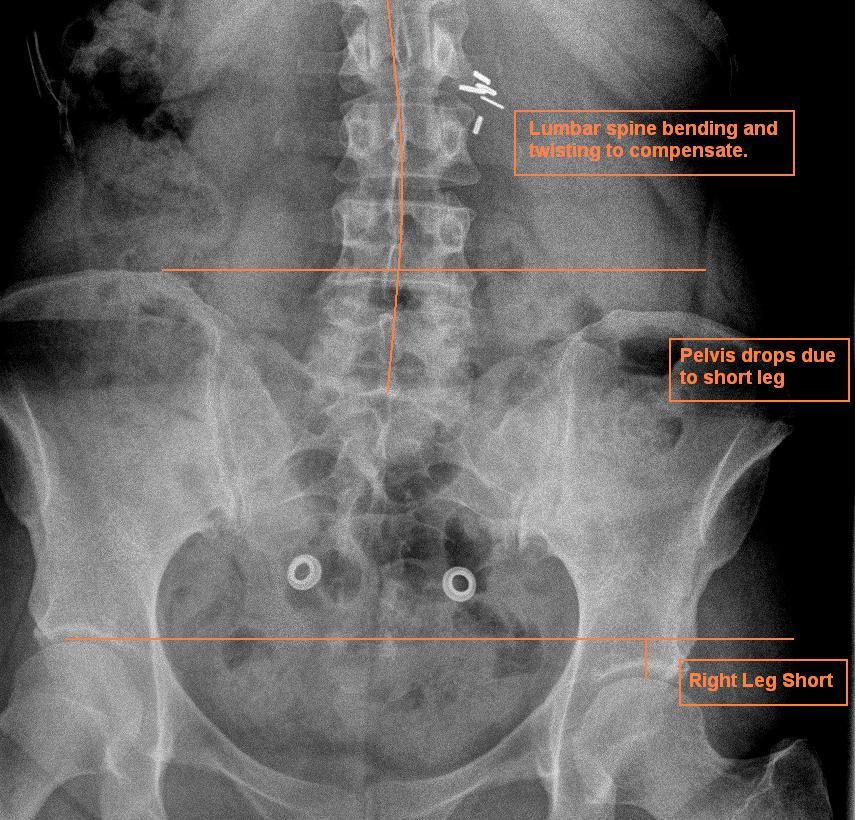Leg Length Discrepancy
The role of Leg Length Discrepancy in spinal pain has been hotly debated for many years. One thing that experts can agree on is that there are biomechanic and posture changes resulting from Leg Length Discrepancy. Most of the debate is related to the degree of acceptable pelvic unleveling. Do we get excited at 5mm change? 10mm? Or do we get even get more aggressive and try to correct a 3mm short leg.
Look at this x-ray below. I took this x-ray recently on a lady who had been having off-and-on lower back pain for months. I marked it up to show the relative loss of leg length. You can clearly see the shift in the pelvis and the bend of the spine resulting from the short leg. There is also some early arthritis changes in the hip and sacroiliac joints because of the chronic stress. The body is designed to share stress loads over the pelvis evenly. In this case, there is much more stress applied to the right hip and sacroiliac joint. This person needs a chiropractor in a big way.

This right short leg is causing the pelvis and lumbar spine to compensate. This causes injury to the lower back.
What causes Leg Length Discrepancy?
When we talk about Leg Length Discrepancy, we are talking about a short leg. One leg is a bit shorter than the other. There can be several causes for Leg Length Discrepancy. The most common are:
- Fracture of a leg bone resulting in a loss of bone length
- Surgery to the foot, ankle, knee or hip
- Trauma to the leg during a period of rapid bone growth
I treat lots of people with lower back pain due to a short leg. Most are completely unaware that they had a problem with leg length. All they knew is that they had a chronic back pain. I suspect that most people with a short leg suffered a trauma to the leg during a period of rapid bone growth.
I think a typical scenario is a 12 year old child jumps out of tree-house, landing hard on a leg. The growth plates of the leg are injured and stunted for several weeks. During the period of recovery, the other leg grows as a normal rate while the injured leg grows more slowly. When the leg recovers, it begins to grow at the normal rate, but it had been behind schedule for a couple of months so that leg is shorter than the non-injured one.
When the child reaches skeletal maturity in the late teens, all bone growth stops. Even though the short leg is behind schedule, the body’s hormones signal all the growth plates to stop growth and to close up. This finalizes the length of the leg.
What injury is created on the body because of a short leg?
Leg Length Discrepancy or short leg syndrome has been implicated in several lower back conditions. There is strong evidence to show a relationship with:
- Hip arthritis
- Sacroiliac pain
- Sciatica
- Scoliosis
- Muscle fatigue of the lumbar spine
- Stress fractures of the leg
- Disc injury and degenerative disc disease
- Altered gait and posture
As a chiropractor, I can treat the pain associated with each of these conditions. But more importantly, one needs to fix the underlying cause of the problem.
Because the short leg is a chronic problem, the associated pain comes and goes. The patient has a sub-clinical problem which can be easily turned into a clinical injury with moderate stress to the lower back. It could be something simple like raking leaves in the yard, or moving light landscaping bricks. These folks typically have reoccurring back pain every few months and the pain lasts for a week or two. The pain is not usually strong enough to keep us from going to work, but it can sure dampen our activities.
What treatments are available to fix the problem?
There are two approaches to treating a patient with Leg Length Discrepancy. The patient came into the chiropractic office because they have pain. So a chiropractor needs to address the pain and inflammation resulting from the short leg. They also need to fix the underlying condition. That is the easy part. A $5 heel lift usually does the trick. If the $5 lift does not take care of it, then your chiropractic physician might look at custom orthotics. Those usually cost about $250, and are worth every penny when they are made correctly.
A journal article published in the journal Gait and Posture back in 2002 looked at this issue and made some recommendations for care.
I am happy to take a look at patients who have leg length discrepancy and develop a treatment plan to correct the underlying condition and treat the degenerative changes.
Dr. Andrew White
Chiropractic Physician St George UT
References:
Gurney B., Gait Posture, 2002 Apr;15(2):195-206.



